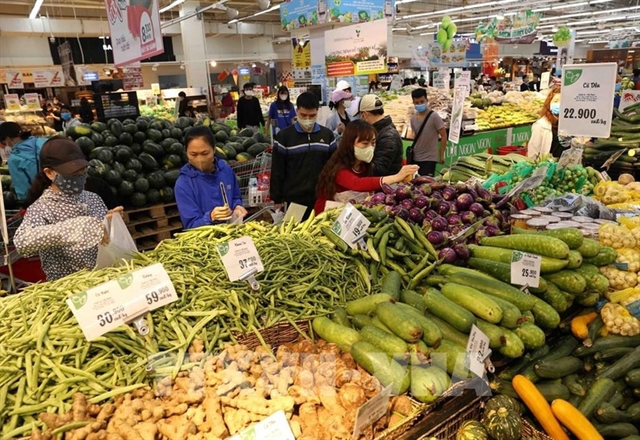

Custard apples have become a great success in the northern province of Bắc Giang. Villagers started to grow them because they liked the fruit. Now, custard apples bring money into the area.
 |
| Nguyễn Văn Cương, a custard apple trader in Lục Nam district. - VNS Photo Linh Anh |
Custard apples have become a great success in the northern province of Bắc Giang.
Villagers started to grow them because they liked the fruit.
Now, custard apples bring money into the area.
by Vy Thảo Anh
The villagers planted custard apples in their gardens because they liked the fruit, but over the last 30 years or so, it has found even greater favour as an economic staple.
The custard apple is among several fruits that have found a niche in the northern province of Bắc Giang, which has emerged as one of the largest fruit-growing areas in the nation.
Different districts in the province has become well-known in Việt Nam and beyond for their lychees, longans, pineapples and custard apples.p
The custard apple, or na in Vietnamese, has become a specialty of the mountainous district of Lục Nam, and local authorities have been encouraging its cultivation with several supporting policies.
The district grows the fruit on 1,700ha, of which 700ha follow the Good Agricultural Practices (GAP) standard.
The custard apples are planted mainly in the communes of Huyền Sơn, Nghĩa Phương, Cương Sơn, Đông Phú, Đông Hưng, and Lan Mẫu.
Huyền Sơn is among those with the largest custard apple area, estimated at 120ha, mainly in the Văn Giang, Giếng Giang and Khuyên hamlets.
In the first six months of the year, the ripe fruit sold for VNĐ25,000-40,000 (US$1.1 -1.7) per kilo. The commune earns about VNĐ30 billion each year from the fruit.
Bùi Văn Quang, director of the Lục Nam Custard Apple Co-operative, which is located in Huyền Sơn, told Việt Nam News that locals had planted custard apples at first for their own consumption.
However, when they took the fruit to the market in the late 1980’s, they found that many people liked the local produce, so they could actually earn big profits.
An earnest effort began in the early nineties to expand planting areas as well as markets for the fruit. At first, the fruit was taken to Hà Nội and soon after, it reached many other localities, including provinces in the central region, Quang said.
Over the past 10 years, custard apples have become the staple fruit in the locality, he added.
Last year, the district enjoyed a yield of 14,000 tonnes of the fruit, 1,500 tonnes higher than the previous year. Lục Nam’s custard apples have achieved a certain brand value now.
New techniques
Quang said when in the early 1990s, when farmers began growing the fruit, each season lasted around two months, starting from June to August, and they only harvested the fruit once or twice during the crop.
This generated reasonable yields and earned modest, but farmers in the district decided to visit other areas where the fruit was grown and learn from their experiences.
The grafting technique thus applied has been a success.
Under the method, farmers would cut a young branch (scion) from a custard apple tree plant with beneficial characteristics like flavour, colour or disease resistance. This would then be attached to the branch of another tree from the same species.
“By combining the trunk of a tree and the scion of another, you can be reasonably sure you will wind up with a reliably hardy and productive plant as it gathers the best characteristics of the two different original plants,” Quang said.
Quang told Việt Nam News that the farmers also took advantage of the remarkable ability of plants to heal and bond.
In the middle of the harvest season they cut branches without fruits. From the junction near the cut, new buds sprout and produce fruits.
Whenever the young buds sprout flowers, growers would hand-pollinate their trees, carrying pots of pollen and paintbrushes with which to individually pollinate every flower. This, Quang said, increases the likelihood of successful pollination compared with that by bees and other insects.
Thanks to the new grafting techniques, farmers have been able to increase yield by at least 20 to 30 per cent, Quang said, adding that the method also lengthened the harvest season and helped them control the time of harvest.
“Instead of lasting just until August, the crop now can be extended much longer, farmers can collect custard apples until November, even December,” Quang said.
Better life, promotion plan
Phương Minh Hiến, who owns a custard apple garden in Huyền Sơn Commune, said that his family has harvested three tonnes of the fruit from the beginning of this year’s season and is expecting to harvest another three tonnes by the end of season.
At VNĐ35.000 - 40.000 per kilo, his family could earn up to VNĐ200 million this year.
Hiến’s wife, Phạm Thị Lương, also said that thanks to the custard apple garden, she her husband could raise three children and take care of their old parents.
The commune is always bustling with sellers and buyers. Traders from other places came to the district, to buy fruit, pack and load to trucks to bring to other provinces.
Nguyễn Văn Cương, a trader, said he started buying custard apples at the beginning of the crop to sell to wholesalers in Hà Nội and many other northern provinces.
“A custard apple grown with grafting technique can weigh 0.5 to 0.7 kg, twice as big as those collected from the first crop and can fetch about VNĐ40,000-50,000 per kilo, double the price of the first season,” Cương said.
However, according to Cương the fruit ripens in one or two days after being cut from the trees, and there is still no way to prevent it from ripening soon.
Therefore, traders cannot export them and only market them in the northern and central regions.
Nguyễn Văn Tùng, deputy director of the Lục Nam District’s Bureau for Agriculture and Rural Development, also said that custard apple was mainly transported to nearby places.
Last year, one enterprise purchased 300,000 kilos of custard apple to export to Dubai, but after a long flight with transit, the products were too ripe at the arrival.
For now, the province is calling for investment and trade co-operation from supermarkets and enterprises in order to promote this local specialty. VNS
GLOSSARY
The villagers planted custard apples in their gardens because they liked the fruit, but over the last 30 years or so, it has found even greater favour as an economic staple.
If custard apples have become an economic staple in villages, it is what all villagers grow in their fields as the main crop they can sell.
The custard apple is among several fruits that have found a niche in the northern province of Bắc Giang, which has emerged as one of the largest fruit-growing areas in the nation.
A niche is a place where there are the perfect conditions for a plant or animal to do well. In this case, conditions in the northern province of Bắc Giang are perfect for growing custard apples.
In the first six months of the year, the ripe fruit sold for VNĐ25,000-40,000 (US$1.1 -1.7) per kilo. The commune earns about VNĐ30 billion each year from the fruit.
Ripe fruit is fruit that is ready to eat.
Bùi Văn Quang, director of the Lục Nam Custard Apple Co-operative, which is located in Huyền Sơn, told Việt Nam News that locals had planted custard apples at first for their own consumption.
Consumption means using something in some way. In this case it is locals’ eating them.
An earnest effort began in the early nineties to expand planting areas as well as markets for the fruit. At first, the fruit was taken to Hà Nội and soon after, it reached many other localities, including provinces in the central region, Quang said.
An earnest effort is a serious effort.
Expanding planting areas means making the planting area larger.
This generated reasonable yields and earned modest, but farmers in the district decided to visit other areas where the fruit was grown and learn from their experiences.
Yields are harvests.
The grafting technique thus applied has been a success.
Grafting is a way of getting trees to grow by planting a twig of one tree into the young stem of another tree.
Thus means “as a result”.
Under the method, farmers would cut a young branch (scion) from a custard apple tree plant with beneficial characteristics like flavour, colour or disease resistance.
If something is beneficial to you it works in your favour.
This would then be attached to the branch of another tree from the same species.
A species of tree is a type of tree.
“By combining the trunk of a tree and the scion of another, you can be reasonably sure you will wind up with a reliably hardy and productive plant as it gathers the best characteristics of the two different original plants,” Quang said.
If a plant is reliably hardy there is a good chance that it will survive through difficult times.
Quang told Việt Nam News that the farmers also took advantage of the remarkable ability of plants to heal and bond.
To take advantage of something means to use so that you get some good out of it.
To heal means to become well again after having been ill or injured.
To bond means to develop a close relationship with another.
From the junction near the cut, new buds sprout and produce fruits.
A junction is a place where two things come together. In this case it would be two branches.
Whenever the young buds sprout flowers, growers would hand-pollinate their trees, carrying pots of pollen and paintbrushes with which to individually pollinate every flower.
Buds are little things on plants that later sprout to become flowers.
To hand-pollinate means to use your hands to help the different parts of the plant that come together in order to turn a flower into a fruit. It is the same job that bees and insects do for the flowers.
Individually means one at a time.
Thanks to the new grafting techniques, farmers have been able to increase yield by at least 20 to 30 per cent, Quang said, adding that the method also lengthened the harvest season and helped them control the time of harvest.
A technique is a way of doing something.
The commune is always bustling with sellers and buyers.
Bustling means crowded and busy.
Nguyễn Văn Cương, a trader, said he started buying custard apples at the beginning of the crop to sell to wholesalers in Hà Nội and many other northern provinces.
Wholesalers are people who sell things to people who will then sell them on to other people.
Last year, one enterprise purchased 300,000 kilos of custard apple to export to Dubai, but after a long flight with transit, the products were too ripe at the arrival.
To export custard apples means to sell them to buyers in another country.
When goods or passengers takes flights with transit, it means that they stop over somewhere between where they leave from and where they are going.
For now, the province is calling for investment and trade co-operation from supermarkets and enterprises in order to promote this local specialty.
An investment is a deal that involves spending money on something in the hope of making more money from it.
Co-operation means working together.
Custard apple is a local speciality because people in the area have spent so much time and effort to grow them well.
WORKSHEET
State whether the following sentences are true, of false:
© Duncan Guy/Learn the News/ Viet Nam News 2017
1. False; 2. True; 3. False; 4. False; 5. True.




